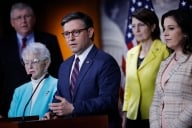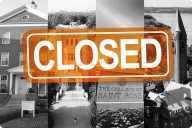You have /5 articles left.
Sign up for a free account or log in.
July 1 was a very good day for former Tufts University administrators climbing the leadership ladder.
Three people who formerly held high-ranking spots at Tufts started as college presidents elsewhere on the first day of this month. Headlining the group is new Harvard University president Lawrence S. Bacow, who was Tufts president from 2001 to 2011. David Harris left his job as Tufts provost and senior vice president, which he had held since 2012, to start as president at Union College, in New York. And Miriam E. Nelson, a longtime Tufts faculty member whose roles included being associate dean and chair of the faculty at its college of civic life from 2014 to 2016, became president at Hampshire College (she had most recently been director of the Sustainability Institute at the University of New Hampshire).
While new presidents often take over on July 1, the day most institutions’ fiscal years begin, three presidents who share a background at a single institution and start on the same day is an intriguing quirk. It comes at a time when Tufts can point to several other leaders in its presidential tree.
Jamshed Bharucha, a former Tufts provost and senior vice president who was president of the Cooper Union from 2011 to 2015, was recently announced as founding vice chancellor of a new institution in India, SRM University-Amaravati, meaning he will lead the new research university. The university’s former arts and sciences dean, Joanne Berger-Sweeney, is president of Trinity College.
That makes Tufts, a Boston-area university with a combined undergraduate and graduate enrollment of just 11,500, an interesting example of a recurring phenomenon in higher education: certain colleges and universities tend to turn up frequently on college presidents’ résumés.
“You do see hot spots,” said Jan Greenwood, partner and president of the search firm Greenwood/Asher & Associates. “If you know the market and have tracked it and watch how people make moves, you know in fact that some of that does go on.”
Such hot spots can be long-lasting or develop for limited periods of time, Greenwood said. She thinks they don’t develop quite as often is it might seem to the outside observer, but certain institutions tend to share talent frequently.
“There was a period where the University of Illinois Urbana-Champaign, University of Texas at Austin and the University of California system were kind of tracking one with the other,” Greenwood said. “That said to a search consultant, if you’re doing a search at UIUC, for example, be sure you don’t ignore Texas at Austin or the UC system.”
What characteristics make an institution more likely to be a source of future presidents? Complexity, for one thing, search experts say. An administrator who fared well managing part of a complex university with multiple colleges -- and often a medical school -- arguably demonstrated the ability to handle the slew of issues he or she will face as president.
Geography can matter, too. Institutions in the college-dense Northeast tend to get more visibility than those in more sparsely populated areas.
Then there’s some chicken-and-egg thinking. Institutions that have produced successful presidents in the past are often expected to produce successful presidents in the future.
Past studies have noted the phenomenon as well. A 2017 report from Deloitte and the Center for 21st Century Universities at Georgia Tech studied over 800 sitting presidents’ CVs and identified a group of institutions it dubbed presidential “talent factories” because several presidents had held positions there as faculty members, deans, provosts or other senior staff members.
The list, unsurprisingly, was heavily tilted toward the Ivy League and other top research universities, but a few unexpected institutions broke in as well: the University of Minnesota, Twin Cities; Indiana University, Bloomington; the University of Michigan, Ann Arbor; Cornell University; Dartmouth College; Brown University; Harvard University; Yale University; Princeton University; the University of Pennsylvania; Johns Hopkins University; Georgia State University; Texas A&M University, College Station; Arizona State University, Tempe; the University of California, Berkeley.
Of course, large institutions also tend to employ more administrators than small ones, making it more likely they’ll produce future presidents. Yet search consultants say they often find good candidates elsewhere.
“Maybe I’m prejudiced because I come out of this world, but it’s the small undergraduate liberal arts colleges,” said Katherine Haley, founder of a higher education executive search and consulting firm, Haley Associates. “Candidates, when I speak with them, talk about that experience in a way that changed them forever. I think it’s the sense of studying across a lot of disciplines and focusing on a lot of ideas.”
Haley is a former president of Gettysburg College in Pennsylvania and Whittier College in California. She’s also been the chair of the board of the Annapolis Group, the organization of the country’s top liberal arts colleges. She has Tufts ties as well -- she received her bachelor’s degree from the university, plus an honorary doctorate awarded when Bacow was president.
An institution like Tufts is a good balance between a research institution and a residential undergraduate experience for aspiring presidents, Haley said. Tufts boasts an unusual breadth of programs and graduate schools for an institution of 11,500 students, including graduate schools for engineering, dentistry, veterinary medicine, biomedical sciences and medicine. A location in the Boston area doesn’t hurt when it comes to administrators being noticed.
“It’s thick with higher education, and I think that creates a certain kind of hotbed,” Haley said. “You have a sense of all of these different organizations and how they work and how they approach things and the variety of approaches they take.”
It can be hard to determine from the outside whether an institution is well run, but having other institutions in an area to hold up for comparison can help. Another factor that can be difficult to define is whether an institution takes leadership development seriously and whether its top brass encourages lower-level administrators to move on to bigger and better things.
Tufts tries to foster leadership internally and externally, said its president, Anthony P. Monaco. It runs programs for new chairs, deans and directors to help them get up to speed in their positions and learn how to manage people. It also budgets for administrators to take part in external leadership development programs.
The university tries to be open about budgets and whether any schools are encountering difficulties. It works to keep its leaders from falling into silos.
“We also try to foster a relationship between, let’s say, the deans of the schools,” Monaco said. “They know that’s an expectation of them when they’re here, that they would not only be looking after their school. I think that offers experiences and knowledge, which probably plays well in interviews and job opportunities, because you have a breadth of experience.”
Monaco believes most leaders feel comfortable talking with him about their career goals and opportunities. The university tries to help leaders gain experience that will help them. If, say, a dean in a professional school is considering jobs that require working with undergraduates, Tufts might arrange for the dean to be on a committee dealing with undergraduate issues.
While Monaco would like to keep top talent within the university, he is of the opinion that holding people back is of no benefit.
“I had that attitude when I was leading, even, scientific research,” said Monaco, a geneticist. “My postdocs, the best thing I could do for them was get them good academic jobs. Holding on to them for longer than they needed, just out of selfish motives, I think that’s not a great sign of leadership. So I think it’s a culture here.”
Trustees have to support that culture as well, Monaco said.
Of course, it can come with downsides.
One drawback is the potential for a large number of simultaneous administrative openings from time to time. It can feel like “search overload,” Monaco said. But open lines of communication can help the institution learn about likely departures in advance. Some turnover also allows for new voices to be promoted and new talent to be hired from outside.
“You don’t want to promote everyone from within, because it can get insular,” Monaco said. “People have different experiences, different ways of doing things, and that’s the healthy part of bringing talent in from outside.”
Those who have been involved in hiring Tufts administrators say it has been strengthened by successive generations of presidents with a clear vision. John Isaacson is the founder of the search firm Isaacson, Miller. He recruited both Bacow and Monaco, and the firm has been involved in searches hiring numerous administrators with Tufts ties, including Harris and Nelson.
Monaco has continued to build Tufts after Bacow elevated the institution’s profile, Isaacson said. Bacow had been chancellor at MIT before coming to Tufts.
“They were always a good place, but he made them a hot school,” Isaacson said of Bacow. “When recruiting for presidents, you want to recruit from some place that has shown ambition and success.”








